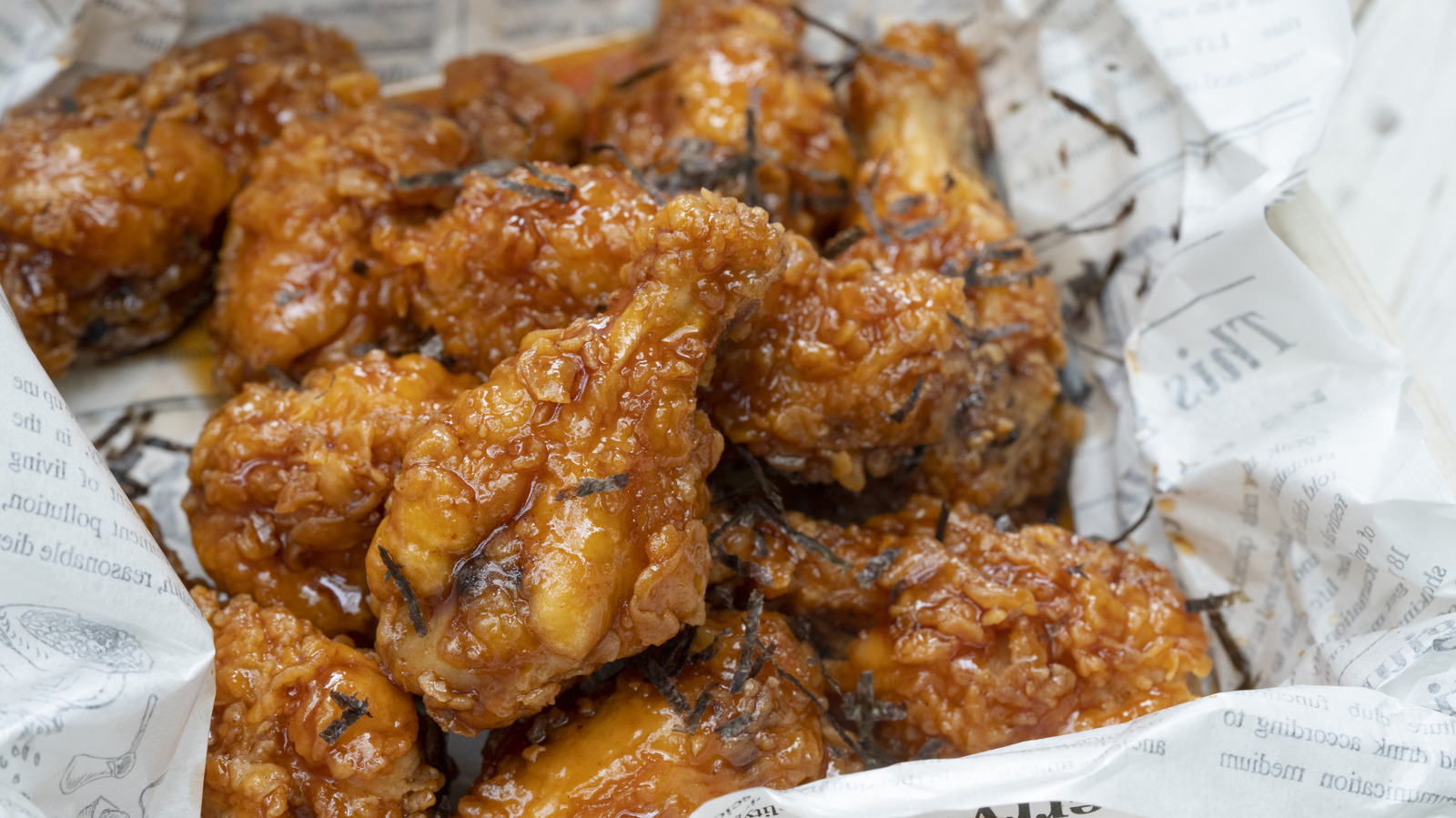Go into any self-respecting sports bar, and you’re certain to see wings on the menu –- and don’t be surprised if you see wings in multiple guises, from fried to classic Buffalo wings to savory lemon pepper and sweet-tangy barbecue-sauce-drenched varieties. And if you’re in a really trendy place, you’ll probably be able to get spicy Korean fried wings as well. Even supermarket delis have gotten into the act, some also offering cooked wings in multiple flavors.
To anyone familiar with the American food scene today, it would appear that saucy chicken wings have been a deeply entrenched part of the national cuisine since forever. But surprisingly, the idea of cooking up wings and drenching them in sauce only came into mainstream popularity in the early 1960s, when the famed Buffalo wing was invented at the Anchor Bar in Buffalo, NY. Before then, however, the delight of deep-fried wings was already an open secret among Black diners –- they knew wings were not only tasty but cheap since everyone else bought them only to make stock if they bought them at all. Today, of course, saucy wings are so widespread they’ve become a bit predictable. We still love them, but how much Buffalo sauce can a person eat? If you’re looking for a way to refresh your wing game, here are some fun and unexpected sauces worth trying.
Venezuelan guasacaca sauce
First, we know it’s nearly impossible to hear the word guasacaca without triggering a smirk from your inner 12-year-old. But now’s the time to tell your inner tween to get a grip otherwise they’ll miss out on a seriously delicious sauce. This bright-green Venezuelan version of guacamole is a traditional accompaniment to marinated, grilled chicken and also makes a refreshingly different dip for grilled or baked chicken wings.
Guasacaca sauce differs from guacamole in several ways. While it starts with mashed avocado, lime, cilantro, and jalapeño, all ingredients found in many guacamole recipes, it includes several ingredients guacamole doesn’t, including vinegar, parsley, black pepper, garlic, and olive oil. It’s also thinner and smoother than guacamole and more pourable than scoopable. It’s a bit like a thick, avocado-based vinaigrette -– rich, yet tangy and herbaceous. Besides being a great dip for wings, it’s also a flavorful accompaniment to vegetables, seafood, and other grilled meats.
Chili crisp
If you’re in the mood for spicy wings but are tired of those familiar Buffalo wings, reach for that jar of chili crisp in your refrigerator. And if you don’t already have a jar of chili crisp in your fridge, get one –- you won’t regret it. This favorite Chinese condiment, now having a moment with North American cooks, consists of chopped chilis, onions, garlic, and spices fried in oil. The solids stay crunchy even suspended in the deeply flavored chili oil, which allows the spicy condiment to add flavor, heat, and crunch to noodles, egg dishes, and more.
Besides being a great table condiment, chili crisp is a fun ingredient to incorporate into recipes. For instance, it makes an easy, spicy sauce for baked wings -– just mix it with honey, vinegar, and olive oil and use the sauce to baste the wings when they’re halfway done cooking. It’s sweet, hot, tangy, and crunchy, everything a spice lover could want in a wing. Even better, the spices in the chili crisp –- which, depending on the brand, can include tingly Sichuan peppercorns, fragrant star anise, cumin, and cardamom –- add an aromatic depth no Buffalo wing can match.
Raita
The inventors of Buffalo wings had an inspired moment when they decided to serve them with celery and blue cheese dressing –- while seemingly odd partners for spicy wings, these crunchy, creamy, and cooling ingredients proved to be a perfect way to balance the fiery sauce. Today, Buffalo wing fans who’re not into the pungent flavor of blue cheese opt for milder ranch dressing instead. But these aren’t the only cooling, creamy condiments that can complement a spicy wing.
Raita –- a cooling classic Indian condiment of yogurt and chopped cucumber –- is a common accompaniment to grilled dishes such as kebabs and tandoori chicken. It can thus be a refreshing partner to tandoori-style chicken wings or even basic grilled or baked wings. It’s also easy to make: At its most basic, it’s simply lightly salted yogurt folded with chopped cucumber, a bit of chopped onion or shallot, chopped cilantro, and a touch of cumin. Numerous variations exist, and you can make it your own by adding flavorful ingredients such as chopped jalapeños, tomatoes, or mint.
Tonkatsu sauce
Basic fried wings –- the kind a good supermarket deli would normally have -– are plenty tasty on their own. But if you’re a culinary maximalist or just want something a little different, a dip in sauce may be all that’s needed to transform routine wings from good to great. We all know the usual suspects: ranch and blue cheese dressing. But while these are classics for good reason, you have other options to explore if you want to change things up.
And you don’t even have to look too hard to find other good options. All you have to do is take a peek at how other cultures serve their fried chicken. In Japan, for instance, fried chicken typically takes the form of a fork-and-knife dish: the popular preparation chicken katsu is a panko-coated, fried chicken cutlet served with rice and topped with tonkatsu sauce, a thick, sweet-salty sauce made to accompany fried meats. (It’s also the standard accompaniment to fried pork cutlets.). It’s also easy to make –- a simple mixture of Japanese Worcestershire sauce, ketchup, and soy sauce.
Sweet and sour sauce
Wings don’t have to be deep fried to be good. For most home cooks, it’s neater and easier to bake them. And if you bake them in the right sauce, the results can be spectacular –- a little crispy, maybe a little sticky, and laden with flavor. Familiar baked-on sauces include barbecue and teriyaki sauce, both of which caramelize during baking, turning the wings into a sticky-sweet delight. But less-common sauces can deliver the same effect while offering a novel twist.
For instance, consider the sweet-and-sour sauce tossed with fried pork chunks in old-school Chinese-American restaurants. Its tangy-sweet flavor cuts through the richness of the fried meat, making the dish seem both lighter and more decadent — each bite makes you want to take one more. This sauce can serve the same function on baked chicken wings. And it’s also easy to make with common pantry staples -– ketchup, vinegar, soy sauce, and if you want to be a bit extra, some pineapple juice.
Feta yogurt sauce
Chicken wings are a big crowd-pleaser because no matter what your taste or mood, you’ll probably be able to find a version you like. Whether your preferences run to sweet and sticky, fried and crunchy, or simple and savory, you’ll find a wing recipe that satisfies your cravings.
Often overlooked in the wing pantheon are simple, un-breaded, un-sauced baked or grilled wings. While they may look austere, they can be loaded with flavor, perhaps from a marinade or a dusting of seasoning. And because they’re so simple, they can pair well with a punchy dipping sauce. For instance, for a summery and sophisticated take on wings, marinate them in a Greek-style marinade of lemon, garlic, olive oil, and herbs and grill or broil them until pleasantly crispy on the edges. They’re flavorful and satisfying straight off the grill, but to add an extra layer of flavor and play up the Greek them, drizzle them with a simple sauce of Greek yogurt whipped with feta, garlic, and lemon juice to taste.
Peri-peri mayo sauce
In Portugal and its former colonies in Africa, the chicken preparation of choice is peri-peri chicken, seasoned with a spicy sauce featuring peri-peri peppers, a close relative to the American tabasco pepper that was introduced to Mozambique from Brazil by Portuguese colonizers. The sauce, which combines African and Portuguese influences, features vinegar, garlic, and lemon, with additional ingredients added as cooks desire. While little known in the U.S., peri-peri chicken has become popular throughout much of the rest of the world, thanks in large part to the South African chicken chain Nando’s.
While Nando’s restaurants have not made much headway in the U.S., its bottled sauces have, and you can simply use them to baste your wings as they bake or grill to add heat and flavor. (Other spice brands also offer peri-peri seasoning, sometimes in powdered form.) Another way to add peri-peri flavoring to your wings is to incorporate it into a creamy dipping sauce -– just add some peri-peri seasoning (and other seasonings such as garlic, if you like) to mayonnaise for a hot-creamy accent for wings.
Dukkah and olive oil
Sometimes, the best sauce for wings isn’t technically a sauce at all. Dry dips –- flavorful, dry mixtures of spices, nuts, and other flavorful ingredients –- are another way to add extra oomph to mildly flavored foods such as bread, plain vegetables, or simply grilled meat. While they haven’t really caught on among U.S. diners, some, such as the beloved Egyptian condiment dukkah, are staples in their homeland.
Dukkah, whose name comes from the Arabic word “to pound,” consists of coarsely pounded (or chopped) nuts, sesame seeds, and spices such as fennel, cumin, and coriander. It was historically devised as an appetizing way to use up leftover nuts, so any nuts you have around can work. (Almonds and pistachios are traditional, but peanuts are also a good option.) It’s traditionally served along with a bowl of olive oil as a two-part dip for bread: You dip the bread in oil, then in the dukkah, which adheres to the oil, for a tasty bite. It’s also used to make a flavorful crust for chicken or meat. So, if you want to take plain baked chicken wings in a new direction, try serving them with a dukkah and olive oil dip.
Nam jim jaew (Thai dipping sauce for meat)
The unapologetically bold flavors of Thai cuisine seem perfectly designed for Thailand’s hot, sticky climate –- the powerful combinations of sweet, sour, funky, and searingly hot flavors will wake up your tastebuds (and the rest of you) no matter how overheated and drained you may feel. A great example of how Thai cooks put these flavors together is nam jim jaew, a favorite dipping sauce for grilled meats.
A bowl of this thin sauce looks unassuming on the table, but don’t be fooled –- it packs a punch. It consists of tangy tamarind concentrate, lime, chopped shallots, fish sauce, dried chiles, and fresh chopped herbs such as cilantro, mint, and scallions. A bit of toasted rice powder stirred in at the end adds body and depth. In Thailand, it’s a popular accompaniment to grilled chicken –- and can make a powerfully memorable partner to a plate of baked or grilled wings as well.
Sauce Beautiful
While the Italian-American proprietors of the Anchor Bar in Buffalo, New York invented the Buffalo wing and its simple, spicy sauce, soul food cooks had been serving fried wings with sauce long before that. A Black restaurateur in Buffalo, John Young, was already offering sauced fried wings at his restaurant Wings and Things around the time Buffalo wings started to appear across town. His sauce, however, was a tangy, tomato-based sauce laced with tropical fruit, which he called mumbo sauce.
In New York, another Black chef, Pamela Strobel, created her own fruity sauce to accompany the fried chicken and other dishes at her East Village restaurant. Both her cooking and supersized personality -– she went by the nickname Princess Pamela –- attracted a crowd of A-listers, including Gloria Steinem and Diana Ross, to her restaurant. If any of them ordered her fried chicken, they would have also gotten a portion of her Sauce Beautiful, a chutney-like mixture of peach preserves, vinegar, brown sugar, Worcestershire sauce, and paprika. If you have the guts to call yourself a princess and call your sauce recipe beautiful, you’d better deliver. And this sauce does.
Chimichurri sauce
Countries with strong traditions of outdoor meat cookery almost always have a go-to sauce to go with their meats. Here in the States, it can be one of our many regional varieties of barbecue sauce. In beef-crazy Argentina, the sauce everyone reaches for during a steak dinner is chimichurri –- an herbaceous, bright green sauce that adds lightness, color, and sparkle to rich grilled meats, including chicken.
It’s unclear how or when chimichurri evolved in Argentina. According to some local legends, it was created by Irish immigrants, while others argue that it’s a local adaptation of a Basque condiment, tximitxurri, brought by Basque immigrants. Today, pretty much everyone agrees that it’s a mixture of finely chopped parsley, olive oil, vinegar, garlic, and oregano. Some cooks add chopped chile or a squeeze of lemon as well. Chimichurri isn’t necessarily spicy (sometimes it isn’t hot at all), but its tangy and savory flavor and pretty color make it a satisfying topping for basic baked or grilled wings.





